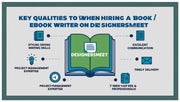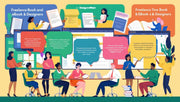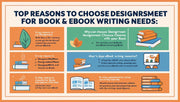Stepping into the world of freelance graphic design can be both exciting and overwhelming. With the flexibility to work from anywhere, choose your clients, and build a personal brand, freelancing offers creative freedom and professional growth. But it also requires planning, discipline, and the right approach to succeed in the competitive design market.
In this comprehensive beginner’s guide, we’ll walk you through the steps you need to take to launch and grow your freelance graphic design career, from setting up your business to finding your first clients and managing projects professionally.
1. Understand What Freelancing Involves
Freelancing means working independently on projects for different clients, rather than being employed by one company. As a freelance graphic designer, you’ll be responsible for:
-
Marketing your services
-
Managing deadlines
-
Communicating with clients
-
Sending invoices and collecting payments
-
Staying up to date with trends and tools
It’s a blend of creativity and entrepreneurship, and understanding both sides is key to thriving.
Keyword Highlight: freelance graphic designer, independent designer, creative entrepreneur
2. Build Your Skills and Portfolio
Before you start offering services, ensure you have a solid foundation in graphic design principles, software, and tools. If you’re still learning, take online courses or practice through personal projects.
Once you have a few quality designs, create a graphic design portfolio that showcases your best work. You can include:
-
Branding projects
-
Logo designs
-
Social media creatives
-
Web and app UI mockups
Use platforms like Behance, Dribbble, or create your own website.
Keyword Highlight: graphic design portfolio, design showcase, creative work samples
3. Choose Your Design Niche
Instead of trying to do everything, focus on a niche that aligns with your strengths and interests. Some common freelance design niches include:
-
Branding and logo design
-
Web and UI/UX design
-
Social media design
-
Infographics and presentations
-
Print design (brochures, flyers)
A clear niche helps you attract the right clients and position yourself as an expert.
Keyword Highlight: design niche, branding specialist, UI/UX freelance work
4. Set Up Your Freelance Business
Even as a solo designer, treat your work like a real business. Start by:
-
Choosing a business name and branding yourself professionally
-
Creating a logo, business card, and website
-
Setting your pricing or hourly rate
-
Preparing contract templates for client agreements
Don’t forget to set up a professional email address and invoicing system using tools like Wave, Bonsai, or PayPal.
Keyword Highlight: freelance design business, graphic design pricing, client contracts
5. Find Your First Clients
Getting clients is often the hardest part for beginners. Try these methods to land your first freelance projects:
-
Ask friends or family for referrals
-
Offer discounted or free work to build a portfolio
-
Join freelance job platforms like Upwork, Fiverr, Toptal, or PeoplePerHour
-
Network on LinkedIn, Facebook groups, and design communities
Make sure your online profiles clearly state your services and include portfolio links.
Keyword Highlight: freelance clients, Upwork for designers, graphic design gigs
6. Communicate Clearly with Clients
Client communication can make or break a freelance relationship. From the first message to project delivery, always be:
-
Clear about expectations
-
Transparent about timelines and revisions
-
Professional in tone
-
Prompt in responding to emails or messages
Consider using project briefs to clarify requirements before starting.
Keyword Highlight: client communication, design briefs, professional project handling
7. Manage Time and Projects Effectively
As a freelancer, your time is your income. Use tools like:
-
Trello or Notion for task management
-
Google Calendar for scheduling
-
Clockify or Toggl for time tracking
Learning to prioritize and avoid burnout is crucial to long-term success.
Keyword Highlight: time management for freelancers, design workflow, task organization
8. Keep Learning and Growing
The design industry changes rapidly, with new tools, trends, and styles emerging constantly. Stay updated by:
-
Taking online design courses
-
Following design influencers on platforms like Instagram or YouTube
-
Reading design blogs and publications
-
Attending webinars or local design meetups
As you grow, you can charge more, attract bigger clients, and even start a design agency.
Keyword Highlight: continuous learning, graphic design trends, upskilling as a designer
Conclusion
Becoming a freelance graphic designer is a rewarding journey that combines artistic talent with entrepreneurial skills. While it comes with its challenges, the freedom and flexibility of freelancing make it an appealing career path for creative professionals.
By building a solid portfolio, choosing a niche, marketing your services effectively, and continuously improving, you can thrive in the freelance world and turn your passion for design into a sustainable business.




